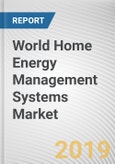The world home energy management system (HEMS) market is segmented on the basis of available product types, communication technology and geography. Based on components, the HEMS market is segmented into hardware and software. Hardware is further bifurcated into sensor, controller & others. Furthermore, the market has been sectioned, based on communication technology, into ZigBee, Wi-Fi, home plug and others. The world home energy management system (HEMS) market has been analyzed based on geographical regions, which include North America, Europe, Asia Pacific and LAMEA (Latin America Middle East and Africa). The key market players profiled in the report, include Schneider Electric, Panasonic Corporation, General Electric Company, Emerson Process Management and others.
Potential Benefits for Stakeholders:
The report provides an in-depth analysis of the home energy management systems market and offers current and future trends to identify lucrative investment pockets in the market
The report identifies the key drivers, opportunities and restraints that shape the market and provides an impact analysis for the forecast period
Porters five forces analysis highlights the potency of buyers and suppliers participating in this market. This would further offer a competitive advantage to stakeholders in making profitable business decisions; thus, helping them to strengthen their supplier and buyer networks
Current and future trends are outlined to determine the overall attractiveness and highlight the profitable trends in order to gain a stronger foothold in the market
Market estimation of geographic segments is derived from the current market scenario and expected market trends
HOME Energy Management System Market Segmentation:
The home energy management system (HEMS) market is segmented based on component, technology and geography
Market by Component
Hardware
Sensor
Controller
Others
Software
Market by Communication Technology
ZigBee
Wi-Fi
Home plug
Others
Market by Geography
North America
Europe
Asia Pacific
LAMEA
Key Players
Schneider Electric
Panasonic Corporation
Honeywell International
Cisco Systems, Inc.
General Electric Company
Emerson Electric Co.
Johnson Controls, Inc.
Siemens AG
AlertMe.com
Blue Line Innovation
Methodology
The analyst offers exhaustive research and analysis based on a wide variety of factual inputs, which largely include interviews with industry participants, reliable statistics, and regional intelligence. The in-house industry experts play an instrumental role in designing analytic tools and models, tailored to the requirements of a particular industry segment. The primary research efforts include reaching out participants through mail, tele-conversations, referrals, professional networks, and face-to-face interactions.
They are also in professional corporate relations with various companies that allow them greater flexibility for reaching out to industry participants and commentators for interviews and discussions.
They also refer to a broad array of industry sources for their secondary research, which typically include; however, not limited to:
- Company SEC filings, annual reports, company websites, broker & financial reports, and investor presentations for competitive scenario and shape of the industry
- Scientific and technical writings for product information and related preemptions
- Regional government and statistical databases for macro analysis
- Authentic news articles and other related releases for market evaluation
- Internal and external proprietary databases, key market indicators, and relevant press releases for market estimates and forecast
Furthermore, the accuracy of the data will be analyzed and validated by conducting additional primaries with various industry experts and KOLs. They also provide robust post-sales support to clients.

LOADING...








